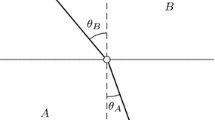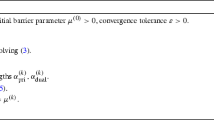Abstract
In this paper, we consider two equivalent differentiable reformulations of the nondifferentiable Euclidean multifacility location problem (EMFLP). The first of these is derived via a Lagrangian dual approach based on the optimum of a linear function over a unit ball (circle). The resulting formulation turns out to be identical to the known dual problem proposed by Francis and Cabot [1]. Hence, besides providing an easy direct derivation of the dual problem, this approach lends insights into its connections with classical Lagrangian duality and related results. In particular, it characterizes a straightforward recovery of primal location decisions. The second equivalent differentiable formulation is constructed directly in the primal space. Although the individual constraints of the resulting problem are generally nonconvex, we show that their intersection represents a convex feasible region. We then establish the relationship between the Karush–Kuhn–Tucker (KKT) conditions for this problem and the necessary and sufficient optimality conditions for EMFLP. This lends insights into the possible performance of standard differentiable nonlinear programming algorithms when applied to solve this reformulated problem. Some computational results on test problems from the literature, and other randomly generated problems, are also provided.
Similar content being viewed by others
References
Francis, R.L. and Cabot, A.V. (1972) Properties of a multifacility location problem involving Euclidean distances. Naval Research Logistics Quarterly, 19, 335–353.
Francis, R.L., McGinnis, Jr, L.F. and White, J.A. (1991) Facility Layout and Location: An Analytical Approach, Prentice Hall, Englewood Cliffs, NJ.
Eyster, J.W., White, J.A. and Wierwille, W.W. (1973) On solving multifacility location problems using a hyperboloid approxima-tion procedure. AIIE Transactions, 5(1), 1–6.
Wesolowsky, G.O. and Love, R.F. (1972) A nonlinear approximation method for solving a generalized rectangular distance Weber problem. Management Science, 18(11), 656–663.
Rosen, J.B. and Xue, G.L. (1993) On the convergence of a hyperboloid approximation procedure for the perturbed Euclid-ean multifacility location problem. Operations Research, 41(6), 1164–1171.
Charalambous, C. (1985) Acceleration of the HAP approach for the multifacility location problem. Naval Research Logistics, 32, 373–389.
Calamai, P.H. and Conn, A.R. (1987) A projected Newton method for Lp norm location problems. Mathematical Program-ming, 38, 75–109.
Sinha, S.M. (1996) A duality theorem for nonlinear programming. Management Science, 12, 385–390.
Love, R.F. (1974) The dual of a hyperbolic approximation to the generalized constrained multi-facility location problem with \(\left( \ell \right)\) p distances. Management Science, 21, 22–33.
Xue, G.L., Rosen, J.B. and Pardalos, P.M. (1996) A polynomial time dual algorithm for the Euclidean multifacility location problem. Operations Research Letters, 18, 201–204.
Bazaraa, M.S., Sherali H.D. and Shetty C.M. (1993) Nonlinear Programming: Theory and Algorithms, 2nd edn. John Wiley, New York, NT, Ch. 6.
Geoffrion, A.M. (1971) Duality in nonlinear programming: a simplified applications-oriented development. SIAM Review, 13, 1–37.
Rockafellar, R.T. (1990) Convex Analysis, Princeton University Press, Princeton, NJ.
Plastria, F. (1992) When facilities coincide: exact optimality conditions in multifacility location. Journal of Mathematical Analysis and Applications, 169, 476–498.
Murtagh, B.A. and Saunders, M.A. (1994) MINOS 5.4 user`s guide. Systems Optimization Laboratory, Stanford University, Stanford, CA 94305.
Lasdon, L.S. and Waren A.D. (1994) GRG2 user's guide. The University of Texas, Austin, TX.
Al-Loughani, I.M. (1997) Algorithmic approaches for solving the Euclidean location and location-allocation problems. Unpub-lished Ph.D. dissertation, Department of Industrial and Systems Engineering, Virginia Polytechnic Institute and State University, Blacksburg, VA 24061.
Zhang, J., Kim N.H. and Lasdon L.S. (1985) An improved suc-cessive linear programming algorithm. Management Science, 31(10), 1312–1331.
Fletcher, R. (1981) Practical Methods of Optimization 2: Con-strained Optimization, John Wiley, Chichester, England.
Calamai, P.H. and Charalambous C. (1980) Solving multifacility location problems involving Euclidean distances. Naval Research Logistics, 27, 609–620.
Author information
Authors and Affiliations
Rights and permissions
About this article
Cite this article
Sherali, H.D., Al-loughani, I. Equivalent primal and dual differentiable reformulations of the Euclidean multifacility location problem. IIE Transactions 30, 1065–1074 (1998). https://doi.org/10.1023/A:1007511830871
Issue Date:
DOI: https://doi.org/10.1023/A:1007511830871




